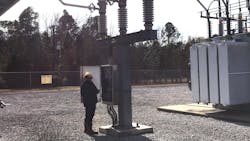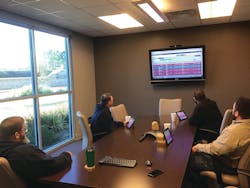Population growth in East Texas has expanded the service territory for Wood County Electric Cooperative (WCEC). When the cooperative first formed in 1938, it started with 1,100 members and delivered 100 miles of energized lines to power remote portions of Texas. Eighty-two years later, the cooperative serves nine counties with about 37,000 meters, manages more than 5,000 miles of line, monitors 127 miles of transmission lines, and supports 29 substations with one metering point, four tap points and two microwave stations.
To handle this load, WCEC has 92 employees, only four of which — a foreman, two power quality technicians, and one meter tester (the Metering and Power Quality group) — are tasked with monthly substation inspections. Lacking a designated substation technician, Wood County also turns to the Metering and Power Quality group for substation maintenance. Depending on the work required, line crews, servicemen, and/or the project engineer occasionally are used for this work, but overall, the Metering and Power Quality group manages the day-to-day responsibilities at substations. Among other things, this includes running underground locates, testing meter accuracy and installing metering equipment at larger loads requiring current transformers and potential transformers.
With an unchanged mission to provide reliable electric service to its members at affordable rates, WCEC embarked on a journey to find technology solutions to more effectively manage its substation inspection process.
Identifying Inefficient Processes
For about 40 years, the process for substation monitoring, inspecting and maintenance remained mostly unchanged and relied heavily on manual documentation. For example, WCEC collected monthly meter readings and other numerical values, such as operations counters and gas pressures from various substation equipment, and recorded them on paper.
Equipment marked with “Needs Work” required inspectors to deliver physical forms to WCEC headquarters so that central office personnel could create work orders (again on paper) and calendar projects for repair. Based on the schedules of substation inspection teams, field reports often were delayed a week or more, which created opportunities for error and oversight.
At the end of the year, completed forms were filed, new forms were printed and the process would restart. Although this system of manual entry ultimately provided the information needed, WCEC leadership recognized that it lacked a level of responsiveness necessary in today’s markets.
Determining Needs
As such, a search for technology solutions to improve asset performance and inspection operations began. WCEC’s leadership stressed the importance of preserving historical data, capturing accurate and timely records and maintaining equipment tracking and inspection schedules that remained robust post-implementation. These priorities led the decision-making process, and in researching digital options, WCEC looked for software products that supported a more proactive approach to operations.
WCEC maintains a variety of equipment, including gas circuit breakers, circuit switchers, power transformers, load tap changers, voltage regulators, current and potential transformers, reclosers, vacuum circuit breakers, electronic controls, meters and control houses, as well as substation components, such as bus work, insulators, lightning arresters and more.
With limited staff covering a large service territory and a growing number of demands related to new and aging infrastructure, WCEC works diligently to address equipment issues before they cause an outage. However, the effects of time, heating and operating stress create natural deterioration on materials and components.
Although a familiar cycle, breakdowns and failures add maintenance, repair, and unexpected service costs. WCEC realized it lacked asset management software to track equipment lifecycles and assist with maintenance requirements. With clearly defined needs established, Wood County staff focused on building efficiency into its process of transferring information, documenting inspection results, tracking equipment, visualizing trends and reporting quickly. Additionally, it wanted a solution that was easy to use. Employees at electric cooperatives often wear multiple hats, so WCEC looked for value-added solutions and avoided those that added time-intensive tools into the workload. The resulting answer to their problem was Substation Maintenance & Asset Reliability Tracking (SMART), an inspection and asset management software designed and developed by MinMax Technologies.
Going Digital
In transitioning the inspection process from paper to a Web-based database management system, WCEC’s expectations for SMART remained simple; it needed to be proactive and user-friendly, both of which were met.
Two functions of the SMART software — Scheduler and Equipment Tracking — significantly modernized WCEC’s approach and enabled the utility to become increasingly proactive in its approach to inspections and monitoring. The Scheduler function allows tracking of inspection intervals while the Equipment Tracking function provides a record for equipment as it gets moved or removed from service. Setting up inspection scheduler and equipment inspection sequences required some planning, but once WCEC imported all necessary information, the transition was smooth.
Currently, WCEC uses SMART for weekly and monthly substation inspections, quarterly downline electronic recloser inspections, tracking work orders, equipment trend analysis and material maintenance for items that expire, such as fire extinguishers and eyewash solutions. Feedback from employees following the first inspection round provided valuable information for making minor adjustments to ensure the system was working as needed.
Instead of paper, inspectors now use tablets to log fieldwork, which allows for the sharing of work order details and coordination of workloads. The platform works on a variety of devices, so while fieldwork requires tablets, the software performs with the same ease on desktops and laptops. Having the ability to export information quickly and share via email was an essential feature for WCEC since some of the information gathered from inspections is used by personnel not linked to the SMART application. While WCEC required no extensive software customization, the MinMax team was responsive to reporting needs and made adjustments and improvements, as needed, to support data analysis. Whereas past analysis required inputting inspection results into tables to assess data; now, just a few clicks generate graphics and charts to streamline that process.
However, the primary benefit has been to operational efficiency, particularly in handling inspection results, and in transitioning to a digital asset management system, WCEC has enjoyed immediate benefits. Not only did it quickly build efficiency into their process by more accurately tracking assets, improving workflow monitoring and streamlining inspection results data analysis, but it also yielded a significant reduction in error reporting. While human error occurs both in electronic and manual reporting, the SMART system has reduced errors by eliminating the need to input data multiple times.
Adapting to Change
While WCEC expected hesitancies among employees, SMART’s intuitive functions quickly eased fears. To begin, WCEC used the Excel import function and populated the templates with substation equipment. Although this took some time, once templates were filled, importing the data into SMART required minimal time and effort. The utility also used SMART’s training database to test the process before going live. Overall, the process was simple, and aside from requesting some additional report capabilities, the software version WCEC selected met the utility’s needs without customization.
MinMax staff also aided in making the experience positive; during implementation and deployment, they remained responsive to questions and provided support. During the transition, SMART team personnel quelled WCEC staff’s initial reluctance by providing hands-on training.
After the first inspection cycle, WCEC leaders, in partnership with MinMax, listened to their teams and made minor modifications based on feedback. Following the second round of inspections, staff never looked back, They credited the software for the added ease and functionality it brought to their inspection and work order processes. From start to finish, decisions remained fact-based and business-driven, and because WCEC staff quickly adapted to the technology, the utility experienced rapid adaptation and deployment.
Unexpected Outcomes
While SMART delivered a tool for paperless substation inspections, the unintended, but positive, outcome became a shift in mindset. Standard practice within the industry is to use time in service and functionality as a basis for maintenance decisions. WCEC operated in a similar vein for over 40 years.
Although past processes delivered results to meet and manage standards adequately, the software conversion process highlighted operational gaps and weaknesses. Using SMART helped WCEC evaluate the process of substation inspections and shift from a mindset focused on using meter readings as the key metric to having a wholistic review of assets.
Conducting trend analysis on inspection data and equipment performance provides utility leaders with the information needed to optimize equipment life cycles and maintenance schedules as well as better manage and maintain facilities.
On the Horizon
While implementing a Web-based software solution for asset management enabled Wood County Electric Cooperative to modernize the inspection process, there remains additional room for growth. SMART offers a range of functionality, and WCEC plans to use the software further.
Items for consideration include tracking maintenance intervals, such as recloser rehabilitation services; transmission line inspections; additional downline equipment inspections, such as regulators and capacitor banks and work performed on equipment and facilities. Additionally, WCEC sees potential use in vehicle management and is working with the MinMax team to develop a possible solution for use in the apprentice lineman training program.
Most importantly, though, the available data now allows WCEC to analyze its system better and take a proactive approach to maintenance and operations. By assessing performance trends and conducting statistical analysis on operating data, including but not limited to, transformers, breakers, regulators and reclosers, WCEC now has a more accurate understanding of key performance metrics. Operational clarity helps WCEC strengthen its reliability, increase member satisfaction and support employee safety while also reducing its environmental impact and assuring full compliance with all laws and regulations.
While change often seems difficult, WCEC established a strong business case for breaking with the status quo and recognized the need for increased efficiency within its current practices. Taking this step toward innovation proved successful, and the cooperative continues to reap the benefits of digitizing their inspection process.
For more information:
Wood County Electric Cooperative | www.wcec.org
MinMax Technologies | www.minmaxtech.com





